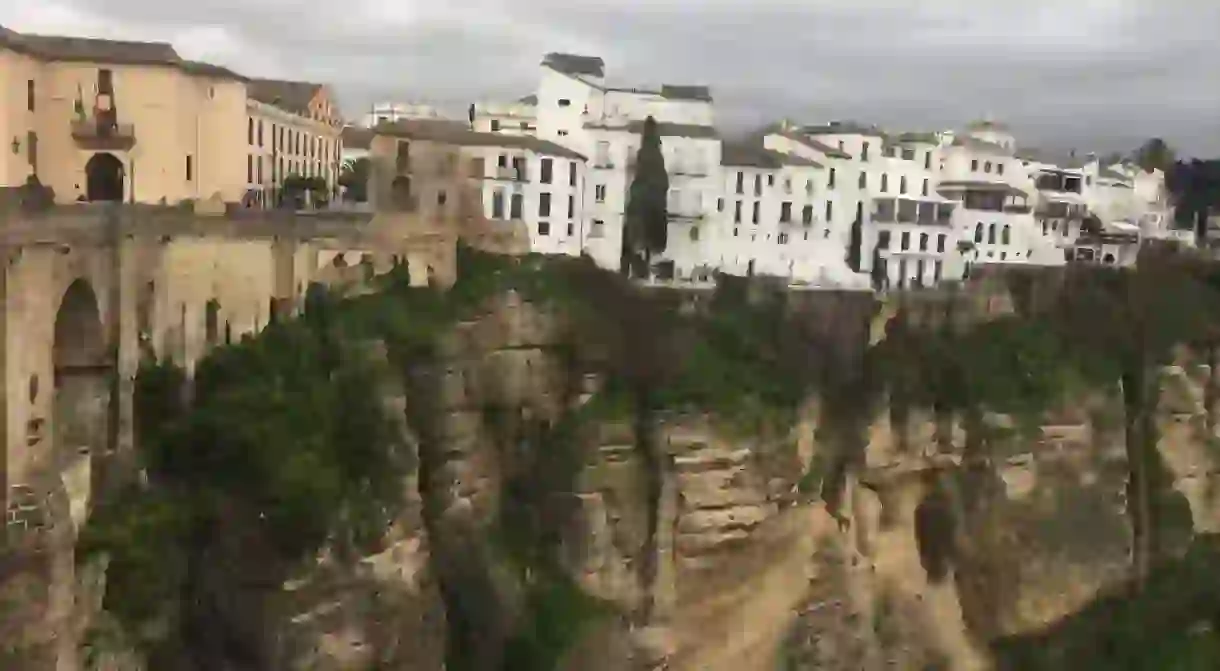How to Spend A Rainy Day in Ronda

Rainy days in Ronda needn’t be washouts. There’s still plenty to see and do on the rare occasions that the sun’s not shining, such as visiting the excellent museums and sheltering in cosy tapas bars. Read on for our guide to spending a rainy day in Ronda.
Visit the museums
If it’s too wet to be outside, spend a morning or afternoon exploring Ronda’s superb museums. The town is said to be the birthplace of the modern Spanish bullfight and in its elegant 18th century bullring – one of the oldest and most important in Spain – is a museum that takes an in-depth look at the history of this controversial spectacle. You can also visit the ring itself, including the chapel where the toreros pray beforehand and the pens where the bulls are kept before entering the arena.
From the bullring, stroll over Ronda’s mighty Puente Nuevo (“New Bridge”), admiring the rain-swept countryside of the Serrania de Ronda as you go. It’s less than a ten-minute stroll to the town’s other standout museum, the Museo del Bandolero, or “Bandits Museum“. The only museum of its kind in Spain, this quirky collection looks at the history of banditry in the wild terrain that surrounds Ronda, particularly during the 19th century, when gun-toting highwaymen were a real problem for travellers approaching the town.

Rainy days in Ronda needn’t prevent you from appreciating the splendour of its key attraction, the scary yet spectacular ‘New Bridge’. Though you might not want to spend too much time hanging about on top (the winds gust around here on stormy days, and in winter it can be bitterly cold), there’s a small but informative museum in the chamber at its centre (visits cost just 2.50 euros), where you can learn about bridge’s construction during the latter half of the 18th century. Chillingly, the cavern that houses the museum was used as a prison during Spain’s 1936-39 Civil War: it is said that prisoners were thrown from it to their deaths on the rocks over 100 metres (328 feet) below.
Check out the Arabic Baths
Hidden as they are on the outskirts of Ronda, outside the old city walls, the Baños Arabes can be easy to overlook. Take advantage of a rainy day to check them out, though, because they are some of the best-preserved Arabic baths in Spain. Dating from the 10th and 11th centuries, they comprise three separate chambers which maintained hot, warm and cold temperatures for the bathers, whilst light and air streamed in from the star-shaped holes in the ceiling.

Hit the tapas bars
Gloomy days in Ronda are the perfect excuse (not that one’s really needed) to take refuge in its many superb tapas joints. Particularly good for eating and drinking is the part of town on the northern side of the canyon known as El Mercadillo (The Little Market), especially the streets around Plaza España. Must-visits are El Lechugita and La Alacena – cosy and lively bars that serve delicious regional cuisine at great prices. Pick a table or a spot at the bar and hunker down for a couple of hours or so.
Enjoy the views
Ronda’s spectacular location means that it offers some of most humbling views in Andalusia – views that you can enjoy on a rainy day just as much as when the sun’s out. Unless it’s absolutely pouring down, take an invigorating walk in the Alameda del Tajo park: along its western extremity, viewing platforms hang out over the edge of the cliff, providing a stunning perspective on the Serrania de Ronda and the mountains of the Grazalema natural park. And to round off a rainy day here, set yourself up for evening drinks at Hotel Don Miguel, which clings to the cliffside next to Puente Nuevo.














